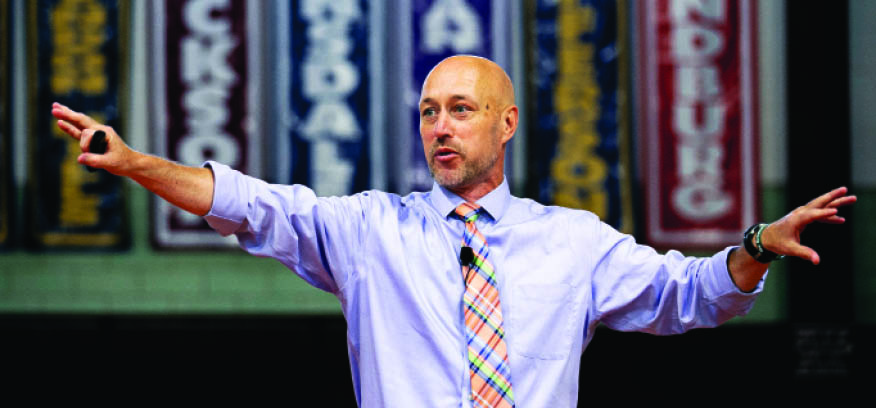“Give Yourself a Chance”

My son loved to run track. In high school, he was a middle-distance runner, so he would find his way around the track once or twice for his events. I tended to yell things at him throughout the race based on how it was going. Moving his arms, breathing, shortening strides, or whatever he specifically needed during that time, but one comment was always consistent … “Give yourself a chance!” I knew that if he was close enough, more often than not, he would find a way to catch almost anyone in front of him. At some point, I asked him how he was usually able to find extra speed at the end of the races. He told me that every step he got closer to the runner in front of him resulted in a jolt of adrenaline and strengthened his belief that he could catch that person.
That still resonates with me today when I think of school leadership, because giving others a chance is what we as leaders do. We are trying to give our kids, teachers, schools, and communities the best chance to be successful. There are no guarantees. There are no magic beans. No one program will ensure success for the people you lead. Everything we do is trying to give us the best chance, and the best chance for us is often to believe that what we do will impact those around us. When we see the impact of what we do, the belief grows. When we don’t see the immediate impact, it becomes harder to move forward because we don’t always know if it’s working. There are some things we can control and other things that we can’t.

Change is one of those things that we can’t always control. Initiatives are constantly knocking at the doors of our schools to the point where the process becomes cyclical. “We did this 20 years ago; we just called it something different” is a statement I have heard more than I care to admit, and it is hard to refute. I take issue with it because it devalues the work of the people who have gone through the process before and, in turn, breeds skepticism with a new process. When change becomes the only constant in schools, people tend to walk with less purpose because they can’t get a handle on what’s next, and they think the work they have already put into the current process was all for nothing. That mentality leads to us checking boxes instead of investing in processes.
I am a checklist person, and I often write down several things that need to be done throughout the day. The interesting thing about the list is that there are not many things on it that bring me joy. They are things that just need to get done. When I am locked into the “get it done” stage, I don’t take a step back to realize the impact of the list because when something goes away, another thing is added.
We can help those we lead to avoid this mentality by providing time, resources, and opportunities to move the organization forward. When we do this, people feel more invested in the process, and therefore own it in a way that provides more value to the entire school or district.
Providing Time
Time is finite. As we try to balance our lives, we also must understand that the decisions we make could take the balance away from others. We have a certain amount of time in the day, after school, and before we start the next day. The thing about time is that everyone values it differently, and they use it in a way that means the most to them.
The first component of offering time is creating an environment where people feel like their time is valued. Meetings that provide information that could be communicated in a different way, too many held at the beginning of the year, or overscheduling professional development days are all things I have been guilty of in the past. They also dilute any social capital you have gained by that point.
Staff meetings can be opportunities, but if the group questions why they are there, that’s a lost opportunity to productively meet. We often talk to teachers about the first five and last five minutes of class. What are we doing in the first five minutes to make sure students feel loved, supported, and safe? What are we doing in the last five minutes to make sure they know why they were there and have the right story to tell when they leave? Taking on the same mentality with staff meetings gives the leader a much better chance to create an opportunity for growth. If we are going to ask our staff to do more or think differently about how they are doing things, it is truly important that they are given the time and information to get better. When learning becomes a checkbox required at a certain time, during a certain day, and in a certain way, that’s not learning; it’s compliance.
But when the environment in your school lends itself to the idea all members of the organization—ages 4, 14, or 40—are there to learn, you establish a place where everyone grows. Providing more time also allows people to reevaluate their current practice. I often hear, “Where am I supposed to add that to my day?” Many of us have trained our staff members to think they must continue to do the work they are currently doing while adding more initiatives to their plate. Giving time allows them to look at their current practice and see what needs to be adjusted. If we don’t provide that time, we will continue to get what we have always gotten, and practice will never change.
Providing Resources
Have you ever attended a youth sporting event? If you concentrate on what is happening on the field or court, it is awesome. Kids working hard, hearts pounding, the swarm of 5-year-olds chasing after a ball and laughing. It’s priceless. It should be a wonderful experience for those kids—and most of the time, it is. Often, though, the adults in that space make it a bit more difficult to handle. Frustration in that space for me comes in the form of adults in the stands yelling “Play harder!” or “Run faster!” Kids work hard and play hard; adults telling them to do it harder isn’t helping. Time is essential, but what to do in that time is just as important. Providing the time but not the resources to get better essentially tells your staff you value their time, but they need to fend for themselves when you give it to them.
When we started the process of providing more resources in my school, I was infamous for lacking specificity when it came to how our days should be structured. When teachers asked me what they were supposed to do for the time we had designated, I would often say, “Get better.” The idea came from a good place. I wanted staff to own their learning and the process they used to get better. However, just telling them to get better was just as bad as saying, “play harder.” If you want people to run faster, you better be able to give them some exercises or drills to run faster. If people are going to “get better,” then we must provide them resources to get better.
Again, knowing where your staff is becomes essential in this process. Being intentional about your conversations with them and what they value allows you to be on the lookout for resources that can help. When you find something that you think may help, send it their way and be sure to reference a conversation or connection you had with them regarding the need for that resource. Emailing them with “thought you may like this” or “thought of you when I saw this” is good, but “I was thinking about the conversation we had the other day about a genius hour, and I really enjoyed talking to you about it. This article touched on the Cardboard Challenge that you were asking about … would love to talk more about it if you get a chance. Thanks for the conversation!” will result in a completely different reaction.
Providing Opportunity
Your school may have 15 or 150 staff members. Either way, the perspective that they have daily comes from what they see during their classes and the opportunity they have to connect with each other. If we don’t provide that opportunity, we are telling our staff that it is not a valuable part of the process. Time and resources are important, but the opportunity comes back to the environment you have established when it comes to improving as a staff.
Keeping time, resources, and opportunity at the heart of what you do when implementing any change allows people to make the connection to work they did in the past and work they will do now and in the future, which helps to prevent them from feeling like they must start over. When we lead in that way, we can best serve others, ensure that everyone moves in the same direction, and reaffirm the shared belief in the work we all do.
Joe Sanfelippo is the superintendent of the Fall Creek School District in Fall Creek, WI, and the author of Lead From Where You Are: Building Intention, Connection, and Direction in Our Schools. He will co-present a session on school culture and climate at Ignite 2023 in July.
To register for Ignite 2023, visit ignite.nassp.org.
